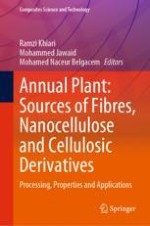This book gives an overview of the processing, properties, and applications of fibers and cellulose derivatives obtained from annual plant materials in the formation of non-wood source of pulp. The book comprises illustrations and tables summarizing the latest research on the production of fibers and cellulose derivatives using several key methods and/or characterization techniques. This book collates the information and knowledge of new ways to prepare cellulosic derivatives and describe the concepts and architecture of fibers obtained from annual plants. This book caters to researchers, policymakers, and industrial practitioners who are interested in natural fibers as a way to preserve the forest resource and to satisfy the increasing demand in pulps.
